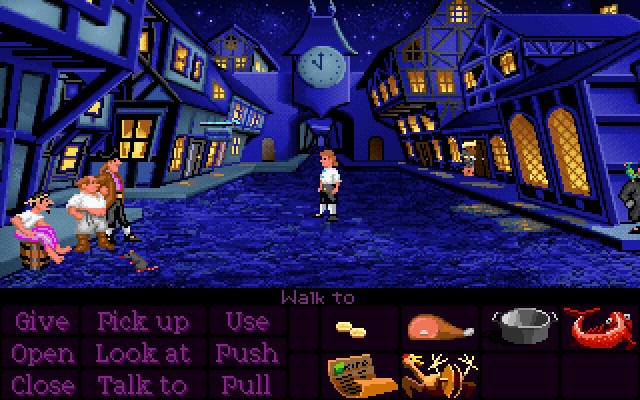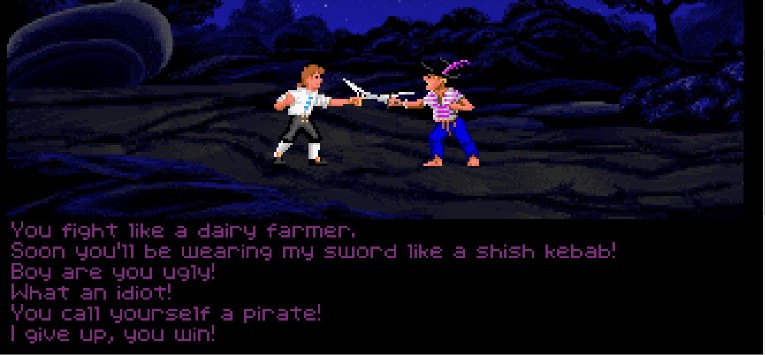In preparation for Return to Monkey Island1, I have decided to replay the first three classic games2.
Frankly, I played only the third one as a child, soon after release. “The Secret of Monkey Island” came out right after Poland became an independent country again, and I was still in kindergarten. Three years later, I received my first computer - a (not so)powerful PC386. I was a kid back then, and I knew very little English. Certainly not enough to comprehend this game. My first play through was sometime around the year 2002.

Running the game
Running this 30-year-old game is amazingly easy, thanks to SummVM3. Just download the emulator, find a copy of the game, and everything runs perfectly on any system. An updated version was released in 2009, but it was never released on Linux, and macOS/iOS versions are no longer working.
You can also play in the browser via Internet Archive4.
If you want the updated version, you can get it on GOG5.
Playing the game
The Secret of Monkey Island is a pirate-themed adventure with lots of humor. The later games focused more on the funny aspect, but we have an interesting story here. Guybrush Threepwood lands on Mêlée Island, where he starts his quest to become a pirate. He will have to pass a test, find true love, and face a ghost pirate LeChuck. Some say that the idea for the game came from Disneyland’s “Pirates of the Caribbean” ride. Some say the movie of the same name stole the idea from the game. The similarities are, for sure, not coincidental. And now, since LucasArts is part of Disney, it all made a giant circle.
The Secret of Monkey Island was one of the earliest examples of adventure gaming done right. You no longer need to guess and type which action the authors envisioned. Instead, the game can be completely operated using a Mouse, as simple verbs represent all actions. This interface has stood the test of time perfectly. I tried (and failed) playing the original Zork games despite the fantastic writing due to the text interpreter. Using the mouse is as simple as it gets. Pro hint: “.” on the keyboard allows skipping dialogue lines in ScummVM.

The graphics aged, but it did it like a fine wine. The game was a marvel when it came out. LucasArts hired actual graphic artists to do computer games. This was still the wild west, and no one knew how to do it. Nowadays, a game can take up gigabytes, and no one bats an eye. LucasArts sold “Monkey Island” on floppies, and every bite counted. Everything we see or hear was a sacrifice of something else. Luckily, Ron Gilbert - the author and primary programmer on the team - was a legend. He created the Scumm engine, which allowed non-technical folks to create games (by writing scripts, not code), but he also managed to find a way to enable the designers to use dithering. You can listen more on YouTube
- A five-hour chat with Ron Gilbert, the creator
- A two-hour interview with Mark Ferrari, designer
- A short one-hour-long interview with Dave Grossman, designer
- Another interview with Ron Gilbert, this time only 45 minutes long
The graphical design is not only a technical marvel but a testament to design done right. The islands look great, and I really wanted to explore them.
But the most significant thing is the idea that the game should not punish players for experimentation. Lucasarts biggest competitor back in those days, Sierra, always found creative and annoying ways to kill the player character. Did you go a pixel too far? You fell from a cliff. Have you met a monster you still lack the means of defeating? Time to die. Sometimes they even completely blocked their progress. For example, in the first “Space Quest,” you are expected to find a pixel-wide item on the very first screen. If you skip it, the game won’t tell you, and you can proceed. Then, a few hours later, you need to use that item however you can no longer access that location. And you are lucky if you even know about it. There was no internet back then to check the walkthrough!
LucasArts also was guilty of this. For example, in the “Maniac Mansion,” you could put a hamster into a microwave. Cooking a hamster seemed funny, but it also blocked the player from finishing the game. Ron Gilbert wrote a short manifesto where he stated that a game should not punish the player but rather encourage him to play. And so, “The Secret of Monkey Island” has no pitfalls. You are never in a position where your prior action blocks you from finishing the game. This has not aged a single day. And, since “The Secret…” is still one of the funniest games ever made, allowing the player to see the funny parts is what makes so many people play it after all those years.
There are still some puzzles that are far from perfect. I solved Chicken with a Trolley puzzle solely because I remembered it after all those years - it’s this bad. Moreover, I had to resort to a walkthrough because the solution was based on wordplay, which was far from natural for someone whose English is a second language. After I learned the solution, it made perfect sense. I have to give it to the authors. Everything in the game makes sense in the context of the game. But there were times I could not make head or tails, and I had to resort to the old “let’s use everything on everything” strategy - and it’s simply not fun to do so.
On the other hand, “The Secret of Monkey Island” is also the home of one of the most fantastic puzzles I’ve ever witnessed - insult swordplay. You need to defeat pirates in a sword fight, but the fight is an insult-response loop instead of an action sequence. First, the pirate insults you, and you need to learn the proper response and use it, then you insult the pirate, and so on. After a few rounds, you either win and advance to another pirate or lose, but you learn some new insults and need to look for a pirate who will know how to reply. Ingenious! A cherry on top - this part was written by Orson Scott, the author of “Ender’s game”.

The game consists of four parts. Out of them, the first one is easily the most polished and exciting. Luckily, it also took roughly half the total playtime of my play through. The rest is still good (and the worst, I’d say, “Flight of the Amazon Queen” good), but the first few hours shine the most, and I am sure this is what most players remember.
Overall, the game was great and (despite some shortcomings) is still extremely fun to play. I sure hope that “Return to Monkey Island” will keep the adventure/comedy ratio from this installment.
And if you get stuck, remember that the “Universal Hint System”6 is the best way to get unstuck without getting a ready answer.
Memories Emporium
What I’ll remember from the game?
Mostly, the amazing world. Mêlée Island looks great and is full of rememberable characters - like the Voodoo Lady or lazy pirates training their pet rat for a circus. LucasArts has the gift of creating exceptional places. Their later game, “Grim Fandango,” shows Rubacava. This is the one gaming place I simply return to from time to time, just to hang out there - but that’s a story for a different time. They create a believable world inhabited but not completely sane people. Love it! I’ll have to return here with my son when he is a bit older.
The insult sword fighting. I guess I already remembered it as I say, “Well, you fight like a cow” from time to time.
Guybrush. Since this is primarily an adventure story, he is fleshed out for an early 90s game. I really like the guy. He is quirky but also driven and a bit insane. Like every good heron should be. And he can hold his breath underwater for solid 10 minutes!
Not bad for a 6 hour game.
-
update from 2023: this is still in progress. ↩︎